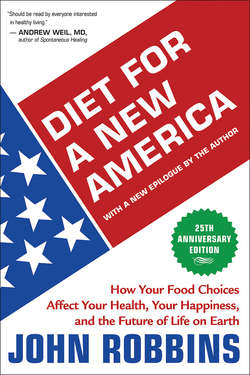Читать книгу Diet for a New America 25th Anniversary Edition - John Robbins - Страница 9
На сайте Литреса книга снята с продажи.
PUBLISHER’S PROLOGUE TO THE 25TH ANNIVERSARY EDITION
ОглавлениеDiet for a New America was first published in 1987. In the following seven years, beef consumption in the United States decreased by 20 percent, from 75 pounds per person annually in 1987 to 60 pounds per person in 1994. That year, during a National Public Radio debate, a representative of the National Cattlemen’s Beef Association accused the book’s author, John Robbins, of being single-handedly responsible for this decline. Of course, many other reasons were responsible as well, but Diet for a New America has played a leading role in changing the way Americans view the food they eat and the industrial food system that produces it.
Since the book’s publication, Robbins has received over 60,000 letters from people who have read the book or heard him speak, describing how the book’s message has changed their lives. Most of them reported either giving up meat or significantly reducing how much they consume. The book’s message has prevented heart attacks and cancer, protected tropical rain forests from destruction, saved species from extinction, and spared millions of animals the cruelty of feedlot and factory farm existences.
A few years after the book was published, the Los Angeles PBS affiliate KCET produced a documentary based on the book, titled Diet for a New America, which became one of PBS’s all-time most successful fund-raising programs. Stations around the country aired it during their pledge drives, receiving an extraordinary response from viewers.
In 2000, largely due to the ongoing impact of Diet for a New America, readers of TheVegetarianSite.com voted John Robbins the most influential individual of all time to the vegan movement. Indeed, when the book was first published, most mainstream Americans viewed the vegetarian lifestyle as the province of “crunchy” granola-eaters. But in the ensuing years, eating a plant-strong diet has moved from the outermost margins of our culture to widespread acceptance.
Today, President Bill Clinton, actors Alicia Silverstone and Woody Harrelson, and comedian Ellen DeGeneres and her wife, actor Portia de Rossi, are vegans, along with countless other celebrities. The list of prominent athletes who have become vegetarian or vegan is long and growing, including nine-time Olympic gold medal winner Carl Lewis, former world heavyweight champion boxer Mike Tyson, baseball slugger Prince Fielder, and Atlanta Falcon tight end Tony Gonzalez, who holds numerous NFL records.
Veganism is also becoming more popular among business leaders: Twitter cofounder Biz Stone, Ford Motor Company executive chairman Bill Ford, billionaire publisher Mort Zuckerman, and music label mogul Russell Simmons have embraced a vegan lifestyle. Steve Wynn, the Las Vegas casino magnate, not only is a vegan but has put vegan options in all his resort restaurants.
Thanks to the ongoing work of medical doctors like Dean Ornish and Caldwell Esselstyn, researchers like T. Colin Campbell, filmmakers like Robert Kenner and Morgan Spurlock, and authors like Jonathan Safran Foer, Kathy Freston, Eric Schlosser, and Michael Pollan, the message of Diet for a New America continues to grow stronger. Americans are growing increasingly aware that what we do to the earth, we do to ourselves; that how we treat animals says something important about who we are as people; and that confining animals in factory farms is wrong and produces food that is damaging to the health of our bodies, our world, and our spirits.
While corporations continue to have great influence, the movement toward food that is organic, sustainable, locally grown, and produced with respect for human and animal rights will continue to grow ever more powerful. We hope this 25th anniversary edition, with a new epilogue from the author bringing the book up-to-date, will introduce a new group of readers to these essential issues.
—Linda Kramer
August 2012
